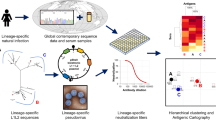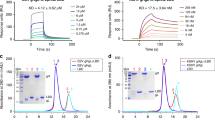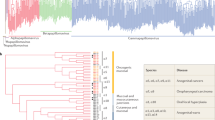Abstract
HERPES simplex virus DNA and RNA have been demonstrated in one specimen of cervical carcinoma1 but these experiments are very difficult to reproduce, possibly because sophisticated hybridisation techniques must be applied to large amounts of tumour cells. In hamster fibroblasts transformed2 by herpes simplex virus 2 (HSV-2), viral RNA sequences have been detected3, but not viral DNA; 60% of these transformed cells reacted with a herpesvirus antiserum, using immunofluorescence techniques applied to unfixed cells4, but the background of positive cells was 10%, in control cells not treated with HSV-2. To confirm or complement hydridisation and immunofluorescence techniques, alternative methods may be useful.
This is a preview of subscription content, access via your institution
Access options
Subscribe to this journal
Receive 51 print issues and online access
$199.00 per year
only $3.90 per issue
Buy this article
- Purchase on Springer Link
- Instant access to full article PDF
Prices may be subject to local taxes which are calculated during checkout
Similar content being viewed by others
References
Frenkel, N., Roizman, B., Cassai, E., and Nahmias, A., Proc. natn. Acad. Sci. U.S.A., 69, 3784–3789 (1972).
Duff, R., and Rapp, F., Nature new Biol., 233, 48–50 (1971).
Collard, W., Thornton, H., and Green, M., Nature new Biol., 243, 264–266 (1973).
Rapp, F., and Duff, R., Cancer Res., 33, 1527–1534 (1973).
Brunner, K. T., Mariel, J. C., Cerottini, J. C., and Chapins, B., Immunology, 14, 181–196 (1968).
Stockman, G. D., Munford, D. M., and Wilbur, J. R., Int. Archs Allergy, 43, 759–765 (1972).
Senik, A., Gossard, E., Plata, F., and Levy, J. P., Int. J. Cancer, 12, 233–241 (1973).
Saksela, E., and Meyer, B., J. natn. Cancer Inst., 51, 1095–1102 (1973).
Boyd, V. A. L., and Butel, J. S., J. Virol, 10, 399–409 (1972).
Melnick, J. L., and Butel, J. S., in Viral Replication and Cancer: Proc. 2nd Duran-Reynals Symposium, 243–254 (Labor., Barcelona, 1973).
Van der Eb, A. J., Van Kesteren, L. W., and Van Bruggen, E. F. J., Biochim. biophys Acta, 182, 530–541 (1969).
Graham, F. L., and Van der Eb, A. J., Virology, 52, 456–467 (1973).
Graham, F. L., Veldhuisen, G., and Wilkie, N. M., Nature new Biol., 245, 265–266 (1973).
Sheldrick, P., Laithier, M., Lando, D., and Ryhiner, M. L., Proc. natn. Acad. Sci. U.S.A., 70, 3621–3625 (1973).
Author information
Authors and Affiliations
Rights and permissions
About this article
Cite this article
SPRECHER-GOLDBERGER, S., THIRY, L. & VANDENBUSSCHE, P. Use of immune lymphocytes to detect expression of herpetic genome. Nature 250, 678–679 (1974). https://doi.org/10.1038/250678a0
Received:
Revised:
Issue Date:
DOI: https://doi.org/10.1038/250678a0
Comments
By submitting a comment you agree to abide by our Terms and Community Guidelines. If you find something abusive or that does not comply with our terms or guidelines please flag it as inappropriate.



